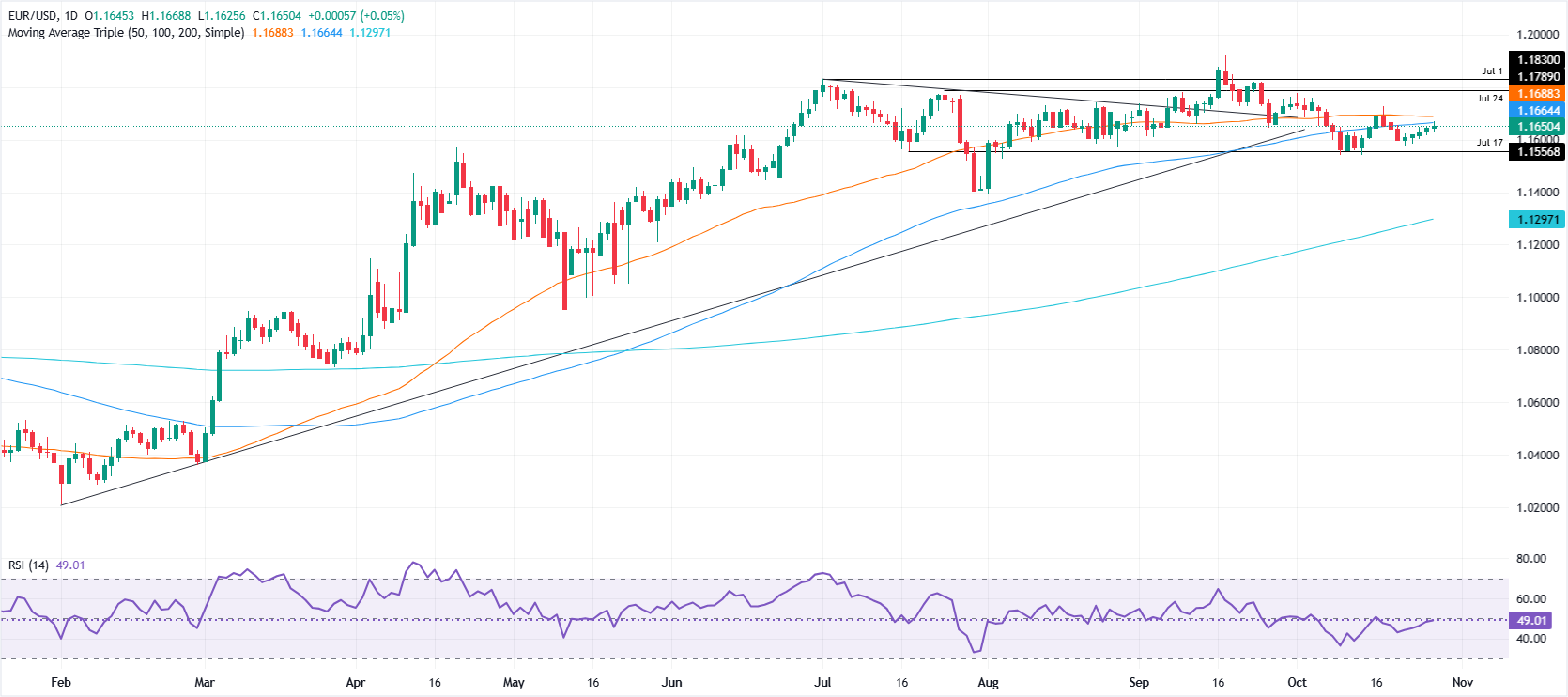- EUR/USD trades at 1.1654 after brief uptick fueled by easing U.S.–China trade tensions.
- US CB Consumer Confidence slips, highlighting softer household optimism.
- Fed expected to cut rates on Wednesday as policymakers remain data-dependent amid shutdown.
EUR/USD registers modest gains on Tuesday, yet it remains trading within familiar levels amid the lack of catalysts as the US government remains shut. However, upbeat news regarding the US-China trade war, weakened the Dollar and boosted the Euro. The pair trades at 1.1654, up 0.09%.
Euro gains 0.09% amid US shutdown and cautious Fed outlook ahead of rate decision
The US and China agreement on a trade framework weighed on the US Dollar, which is usually sought as a safe-haven asset. Also, data showed that US households are growing less optimistic about the economy as shown by the Conference Board (CB) Consumer Confidence data for October.
Aside from this, traders’ attention turned to the Federal Reserve’s monetary policy decision on Wednesday. The Fed is expected to reduce borrowing costs, even though the central bank is data-dependent, but the government shutdown, keeps the markets and the Federal Reserve, leaning on past data.
In Europe, the European Central Bank (ECB) Consumer Expectation Survey revealed that one-year inflation expectations slip from 2.8% to 2.7%, while the three year, remained steady at 2.5%.
Meanwhile, the European Central Bank is expected to hold rates unchanged at 2% on Thursday, which could lend further support to the shared currency.
Daily market movers: EUR/USD advance capped by France political turmoil
- The US Dollar Index (DXY), which tracks the performance of the buck versus six currencies, edges down 0.11%, down at 98.68.
- The Consumer Confidence revealed by the CB witness the index falling to 94.6 in Octoberm from a revised 95.6 in September, the second consecutive monthly decline. The survey showed that households are worried about the availability of jobs over the next six months and persistently higher prices because of tariffs on imports.
- The survey also found that inflation expectations for the year ahead increased by 5.9%.
- Traders are also focused on the prospect of trade deal between the United States and China ahead of a meeting between Trump and Chinese President Xi Jinping in South Korea on Thursday.
- The debate in France regarding the budget is ongoing, with focus on a potential wealth tax. France’s Socialist Party warned it is prepared to bring down the government by the end of the week unless next year’s budget includes a substantial tax increase on the wealthy.
Technical outlook: EUR/USD subdued, upside capped by key moving averages
EUR/USD remains downward pressured, with the technical outlook suggesting limited upside potential unless key resistance levels are cleared. The pair faces immediate resistance at the 100-day Simple Moving Average (SMA) of 1.1664, followed by the 50-day SMA at 1.1686. A break above the latter would expose the 1.1700 threshold.
On the downside, support is seen at 1.1600, followed by 1.1550 and 1.1500. A decisive move below this zone would open the way toward the August 1 cycle low near 1.1391.

Euro FAQs
The Euro is the currency for the 20 European Union countries that belong to the Eurozone. It is the second most heavily traded currency in the world behind the US Dollar. In 2022, it accounted for 31% of all foreign exchange transactions, with an average daily turnover of over $2.2 trillion a day.
EUR/USD is the most heavily traded currency pair in the world, accounting for an estimated 30% off all transactions, followed by EUR/JPY (4%), EUR/GBP (3%) and EUR/AUD (2%).
The European Central Bank (ECB) in Frankfurt, Germany, is the reserve bank for the Eurozone. The ECB sets interest rates and manages monetary policy.
The ECB’s primary mandate is to maintain price stability, which means either controlling inflation or stimulating growth. Its primary tool is the raising or lowering of interest rates. Relatively high interest rates – or the expectation of higher rates – will usually benefit the Euro and vice versa.
The ECB Governing Council makes monetary policy decisions at meetings held eight times a year. Decisions are made by heads of the Eurozone national banks and six permanent members, including the President of the ECB, Christine Lagarde.
Eurozone inflation data, measured by the Harmonized Index of Consumer Prices (HICP), is an important econometric for the Euro. If inflation rises more than expected, especially if above the ECB’s 2% target, it obliges the ECB to raise interest rates to bring it back under control.
Relatively high interest rates compared to its counterparts will usually benefit the Euro, as it makes the region more attractive as a place for global investors to park their money.
Data releases gauge the health of the economy and can impact on the Euro. Indicators such as GDP, Manufacturing and Services PMIs, employment, and consumer sentiment surveys can all influence the direction of the single currency.
A strong economy is good for the Euro. Not only does it attract more foreign investment but it may encourage the ECB to put up interest rates, which will directly strengthen the Euro. Otherwise, if economic data is weak, the Euro is likely to fall.
Economic data for the four largest economies in the euro area (Germany, France, Italy and Spain) are especially significant, as they account for 75% of the Eurozone’s economy.
Another significant data release for the Euro is the Trade Balance. This indicator measures the difference between what a country earns from its exports and what it spends on imports over a given period.
If a country produces highly sought after exports then its currency will gain in value purely from the extra demand created from foreign buyers seeking to purchase these goods. Therefore, a positive net Trade Balance strengthens a currency and vice versa for a negative balance.